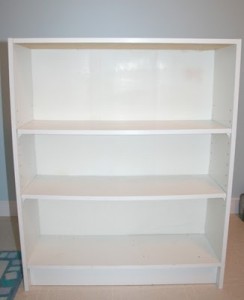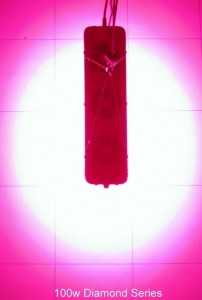Very Small – LED Bookshelf Personal Stash Garden – Great for light to moderate smokers.
- Required Space – 1′ x 3′ x 4′ shelf
- Equipment Costs – $414 to $456 – 100 watt LED ($265), shelf + materials (approx. $30 to $50), vent fan ($20), timer ($16), containers (3x $10), soil ($20 – $30), organic fertilizer ($24 to $36), hygrometer ($9)
- Electrical Costs – $4 to $8 per month, or from $8 to $24 per harvest – $4/month at $0.08/kwH, $5/month at $0.12/kwH, or $8/month at $0.18/kwH
- Vegetative growth time – 1 to 2 weeks
- Estimated Yields – 1 – 2.25 oz. per harvest (0.33 – 0.75 oz. per plant) – Please note, yields are estimated for new growers using this recommended system of soil and fertilizers. Yields will vary significantly depending on strain choices, grower experience and care. With experience and heavy-yielding strains, your harvests may be significantly more massive than these.
This “Very Small” LED bookshelf option is discrete, easy to manage and productive.
Grow strains known to be heavy producers (no pure Sativas!) at first to ensure you will have enough. Yields will increase with experience. Costs below include electricity (for light and fan) and purchasing soil and fertilizer as needed. Costs should not vary much from those listed below, though yields can vary considerably.
- After 1 year of use, this setup costs $548 to $643 and yields 5 to 11.25 ounces. ($49 to $129 per ounce)
- After 2 years of use, this setup costs $706 to $854 and yields 10 to 22.5 ounces. ($31 to $85 per ounce)
- After 3 years of use,this setup costs $852 to $1,053 and yields 15 to 33.75 ounces. ($25 to $70 per ounce)
LED Bookshelf Setup

To set up this garden, I find that an old or cheap bookshelf is the best place to begin. If you don’t have a bookshelf you can use, try to find one at a thrift store. If you’d prefer to purchase a grow tent to avoid the hassle of building, Check out my 2′ x 2′ HID or LED grow tent setups.
To re-purpose a bookshelf, make sure the dimensions are right (1′ deep x 3′ wide x 4′ or taller) and that the backing is light-tight. The front of the bookshelf will need a door or two, which also must be light-tight. Flowering marijuana plants can receive no light during their 12 hours of darkness each day, or they can produce seedy buds.
Plywood is an easy and affordable material to use, and a home improvement store will cut pieces to the sizes you need. The inside of the space should be covered in reflective mylar, plastic or even flat white paint. This will increase the amount of reflected light in the space, which is incredibly important. Make sure the inside floor surface is waterproof and will not drip on to any carpet.
The LED bookshelf will need air moving through it, and this is best accomplished by drilling several small holes near the bottom of the backing of the shelf and covering them with a dark air filter or clean cloth. A small fan, designed for cabinets, is mounted either in the top of the grow space or in the back, near the top. Check out my pest prevention series to keep pests from destroying your crops, and for air flow tips.
It is very important that steps are taken to prevent any light from entering any of these ventilation holes. The combination of vent covers and dark air filters is usually enough to block out household light, but remember that sunlight is far more intense.

An inexpensive hygrometer (thermometer + barometer) is a great way to make sure your temperature and humidity are not too high or low. Temperatures should stay around 75 degrees and humidity should stay between 40% and 60%. If your humidity is a little low, as is often the case here in Denver, you can use a humidifier somewhere nearby (but not in the shelf) if you choose. This is helpful, but not absolutely necessary.
The DS100 from Advanced LED Lights is perfect for this garden, and is very reasonably priced for an LED grow light. It generates very little heat, so it can be kept very close to the plants. Clones should be grown for 1 to 2 weeks with 18 hours of light per day, until they are over 1′ tall. The timer should then be changed to 12 hours per day to induce flowering.
Planting and Feeding
I recommend using 2-gallon Air Pots for your containers, which are reusable and can be ordered online or found at many Colorado garden supply or hydroponics stores. Use a high-quality soil or soil-less mix like Sunshine, Fox Farm or Royal Gold. Do not order your soil online, the shipping costs are a nightmare and many high-quality soils are available at your local garden centers and grow shops. If you aren’t sure which soil you should use, the employees should be able to recommend one or more for you.
To feed your plants, I always recommend Age Old Organics because of their relatively low price, easy use and great results. Age Old Grow is used for the first week, during vegetative growth, and Age Old Bloom is used until 10-14 days before harvest, after which only plain water should be used.
I also recommend Age Old Kelp, (full of micro-nutrients) used at half-dilution along with the regular nutrients, the first feeding and every third feeding afterward. This is not necessary, but I believe it improves results. These 2 or 3 (1 quart) bottles of nutrients should last you several growth cycles (especially the Grow and Kelp) and cost around $12 per bottle.
Use the directions for indoor plants on the labels, and please remember, it is better to underfeed than to overfeed your plants. Start with the lower recommended dilution rates and experiment with heavier dilution rates on 1 of the plants if you are concerned that they are growing slowly. Different strains have different needs too.
The plants should be about 20″ – 30″ tall (not counting the containers of course) at harvest, depending mostly on the traits of the chosen strain(s).
Environmental conditions like temperature, humidity and fertilizing issues can also effect plant size and harvest weights. Some strains tend to stretch a lot and may get too large for this setup. Pure Sativas, with the exception of Durban Poison, will probably grow too tall for this LED bookshelf garden.









